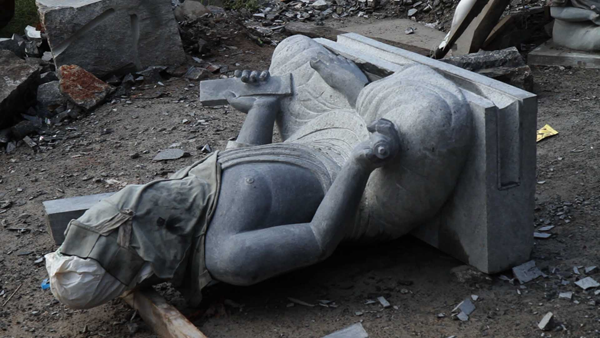Camille Henrot

Le Songe de Poliphile (2011) – Film viscéral
Dans son dernier film, Camille Henrot articule à un rythmé effréné des images tournées en Inde qui connectent l’Orient à l’Occident et mettent en scène les fantasmes réciproques des deux entités culturelles. Une Inde perçue tel « un monde comme celui des rêves » (selon Jung), familière dans son étrangeté, libératrice dans les peurs qu’elle génère. Via le motif du serpent qui incarne aussi bien la menace qu’une pulsion féroce de vie, le montage ondule entre une réalité spirituelle et matérielle : du rituel hindou en l’honneur de Shiva au pays devenu premier exportateur de produits pharmaceutiques, en passant par le venin de l’animal, à la fois tueur et guérisseur. Par la construction en réseau d’associations intuitives entre les images, le récit repose, à l’instar des films des avant-gardes des années vingt et trente, sur un type de montage alterné — dont raffolait notamment Epstein — que vient soutenir la musique. Camille Henrot a fait le choix, en collaboration avec le musicien Joakim, de produire une trame qui accélère le rythme cardiaque, à l’image de la danse de Katakali qui nous est donnée à voir. Mais elle se revendique tout aussi bien du film d’horreur qui naîtrait dans l’accumulation de détails, ou encore des stratégies des vidéos clip qui cherchent, dans une certaine « vulgarité des évidences », à provoquer l’inconscient du spectateur et son émotion. Parce que, comme le dit Barthes dans Fragments d’un discours amoureux : « plus un roman d’amour est vulgaire, banal, et plus il se rapproche de la vérité du monde fantasmé de l’amoureux. »
http://www.camillehenrot.fr
The Dream of Polyphilus (2011) – A Visceral Film
In her latest film, and at a frenetic pace, Camille Henrot organizes images shot in India which connect East and West, and present the mutual fantasies of both cultural entities. An India seen as “a world like that of dreams” (to quote Jung), familiar in its strangeness, and liberating in the fears it gives rise to. Through the theme of the snake, which incarnates threat as much as a fierce life force, the editing wavers between a spiritual and material reality: from the Hindu ritual honouring Shiva to the country that has become the number one exporter of pharmaceutical products, by way of animal venom, which can be at once death-dealing and healing. Through the networking of intuitive associations between images and as in certain avant-garde films of the 1920s and 1930s, the narrative is based on a type of alternated editing—which Epstein, in particular, was crazy about—that underpins the music. Camille Henrot has made the choice, in association with the musician Joakim, to produce a plot which speeds up the heartbeat, like the Katakali dance which we are shown. But she also acknowledges the horror film that is created in the accumulation of details, and video clip strategies which, within a certain “vulgarity of obviousness”, seek to provoke the viewer’s unconscious and his emotion. Because, as Barthes puts it in Fragments d’un discours amoureux (A Lover’s Discourse: Fragments): “The more vulgar and banal a love novel is, the nearer it gets to the truth of the world fantasized by the lover.”
- Partage : ,
- Du même auteur : Jean-Charles Hue, Isabelle Prim,
articles liés
Shio Kusaka
par Sarah Matia Pasqualetti
Julian Charrière : Espaces culturels
par Gabriela Anco
Matthias Odin
par Sarah Lolley


